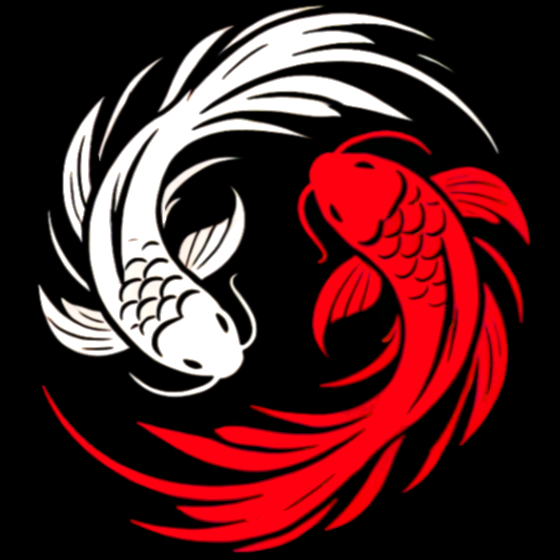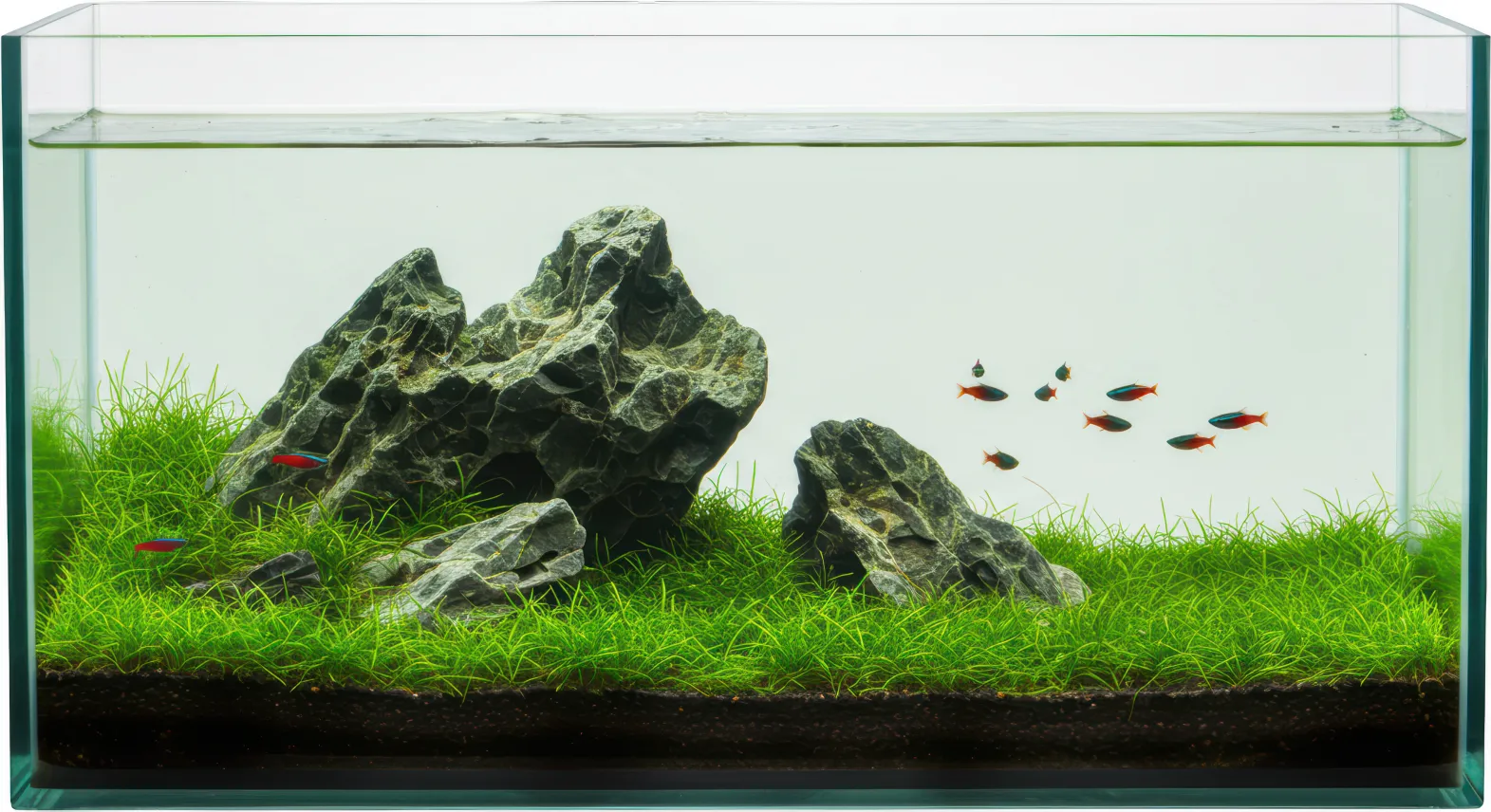Introduction to Iwagumi Aquascaping
The word Iwagumi (岩組) is made up of two Japanese characters: 岩 (iwa), meaning “rock,” and 組 (gumi), meaning “group,” “set,” or “arrangement.” It refers to an aquascaping style rooted in the philosophical principles of simplicity, restraint, and the beauty of imperfection. The discipline emphasizes creating harmony with as little as possible, where every stone has meaning and every space is intentional.
Core Principles of Iwagumi Style
侘寂 (Wabi-Sabi) — The Beauty of Imperfection and Impermanence
At the heart of Iwagumi lies the influence of 侘寂 (Wabi-Sabi), a traditional Japanese aesthetic that values simplicity, natural imperfection, and the quiet beauty of impermanence.
侘 (Wabi) refers to a rustic simplicity and an appreciation for understated, modest beauty. It embraces solitude, natural form, and the elegance of things that are unrefined or imperfect.
寂 (Sabi) speaks to the passage of time, the patina of age, and the serene dignity of wear. It reflects a peaceful acceptance of change, weathering, and the impermanence of all things.
In an Iwagumi layout, wabi-sabi reveals itself through irregular stone shapes, asymmetrical compositions, and subtle imperfections that mimic the raw, unmanipulated forms found in nature. There is no pursuit of symmetry or perfection—instead, the aquascaper works in quiet collaboration with the materials, embracing what is naturally present rather than forcing balance.
As plants grow and shift over time, the layout changes—further reflecting the sabi element of impermanence. This evolving beauty is not seen as decay or disorder, but as an essential part of the aesthetic. Wabi-sabi encourages restraint, humility, and mindfulness, reminding us that what is imperfect and transient often carries the most profound beauty.

Rock Composition and Hierarchy
The defining characteristic of an Iwagumi aquascape is the use of stones as the main focus. The layout usually features:
親石 (Oyaishi) — Main Stone
As the largest and most dominant rock in the layout, the 親石 (Oyaishi) serves as the visual anchor of the composition. The rest of the design unfolds around it, with every other element positioned in relation to its presence. Typically placed slightly off-center to avoid rigid symmetry, the Oyaishi carries roughly one-third of the layout’s visual weight.
副石 (Fukuishi) — Secondary Stones
The 副石 (Fukuishi) is the second-largest rock and serves to balance the visual tension created by the off-center placement of the Oyaishi. It is placed in a complementary position to reinforce the natural flow of the layout and guide the viewer’s eye across the aquascape.
添石 (Soeishi) — Tertiary Stones
The 添石 (Soeishi) are smaller stones used to add detail, rhythm, and continuity to the composition. Carefully placed, they help bridge the visual space between the main and secondary stones, contributing to a stable and organic appearance.
据え石 (Sueteishi) — Sacrificial Stones
The 据え石 (Sueteishi) are the smallest and most discreet stones in the Iwagumi arrangement. They serve as subtle accents that support the composition filling small gaps to reinforce the spatial relationships between larger elements without calling attention to themselves. As plants gradually grow in, the Sueteishi may become partially or completely hidden—hence their name, which implies something quietly placed or set into position.
The Rule of Odd Numbers
Iwagumi layouts typically use an odd number of stones (3, 5, 7, etc.). An even number of stones creates unnatural symmetry in the mind of the viewer. In contrast, an odd-numbered arrangement introduces asymmetry that feels more natural and dynamic to the human eye.
Simplicity and Open Space
Equally important as the dramatic hardscape in an Iwagumi layout is the use of negative space. In classical Iwagumi, this often takes the form of bare sand or trimmed plant carpets, creating clean, open areas within the composition. The purpose of this principle is to provide visual relief from the more striking elements and to enhance clarity throughout the layout.
Flora
Plant selection in Iwagumi setups is intentionally minimal, reflecting the style’s emphasis on simplicity and cohesion. Typically, only one or two or three species are used. Iwagumi designs rely on low-growing carpeting plants that create a clean, uniform foreground, enhancing the prominence of the stones and furthering a natural sense of scale. These plants are chosen not for variety, but for their ability to unify the layout and complement the composition without overwhelming it. They soften the contact points between stones and substrate, blending sharp transitions and preventing the layout from appearing too rigid.
流れ (Nagare) — The Evolution and Flow of Iwagumi Over Time
While rooted in tradition, Iwagumi (岩組) has not remained static. Like the natural landscapes it emulates, the style has gradually evolved—shaped by innovation, shifting aesthetics, and the growing global aquascaping community. From its foundational principles of stone arrangement and minimalism, Iwagumi has expanded into a broader, more flexible form of expression.
At its essence, Iwagumi continues to reflect 流れ (nagare), the Japanese concept of flow or movement—not just in water or design, but in the quiet evolution of the style itself. It is a living tradition, responsive to time and technique, yet always rooted in the timeless beauty of natural form.
While rooted in tradition, Iwagumi (岩組) has not remained static. Like the natural landscapes it emulates, the style has gradually evolved—shaped by innovation, shifting aesthetics, and the growing global aquascaping community. From its foundational principles of stone hierarchy and minimalism, Iwagumi has expanded into a broader, more flexible form of expression.
Modern Iwagumi layouts often reinterpret the classical rules, embracing creative freedom while honoring the essence of the style. Some examples include:
Using more than three plant species, often blending subtle textures and tones for added depth while still maintaining overall harmony.
Creating complex rock structures composed of several smaller stones treated as a single visual mass, rather than adhering strictly to the single-Oyaishi model.
Incorporating sand paths or exposed substrate as part of the hardscape, enhancing movement and spatial depth in the layout.
Featuring multiple Oyaishi or prominent stones, each with corresponding secondary and tertiary stones, allowing for more expansive, landscape-inspired scapes.
Though these variations may deviate from traditional Iwagumi minimalism, the foundational principles remain intact: balance, flow, imperfection, and intentional restraint. The style continues to reflect 流れ (nagare), the Japanese concept of flow—not only in visual movement but in the organic evolution of Iwagumi itself.


